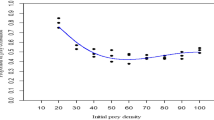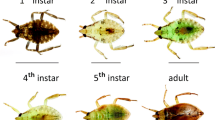Abstract
Experiments were carried out to determine the factors that influence the feeding behaviour of Culex tigripes, a mosquito whose larvae are predators of other mosquito larvae. The results indicated that the efficiency of predatory activities of Cx tigripes larvae increased as they developed from 1st to 4th instar with regard to the number of mosquito prey larvae they consumed in a given period of time. Fourth instars of Cx tigripes are the most voracious of all the stages and are better adapted for catching and consuming all stages of mosquito larvae. The mean number of mosquito larvae consumed in 24 hours increased with increasing prey density. When offered a mixture of different prey species and larval stages, Cx tigripes larvae consistently selected 4th instars of mosquitoes over pupae and preferred Aedes aegypti larvae to the larvae of Cx quinquefasciatus and Anopheles gambiae. Prey size, density and mobility were also found to influence prey selection by Cx tigripes.
Résumé
Des expériences ont été effectuées pour déterminer les facteurs qui influencent le comportement d’alimentation des Culex tigripes, un moustique dont les larves sont des prédateurs d’autres larves de moustique. Les résultats ont montré que l’efficacité des activités prédatrices des larves de Cx tigripes augmentait pendant qu’elles évoluaient du 1er au 4ème stade larvaire quand on considère le nombre de larves de moustique qu’elles ont consommées dans une période donnée. Les larves du 4ème stade de Cx tigripes sont les plus voraces de tous les stades larvaires et les mieux adaptées à la capture et à la consommation des larves autres moustiques. Le nombre moyen de larves consommées en 24 heures a augmenté avec l’acroissement de la densité des proies. Mises dans un millieu contenant un mélange de différentes espèces de proies, les larves de Cx tigripes ont montré une préférence pour les larves d’Aedes aegypti au détriment de celles de Cx quinquefasciatus et d’Anopheles gambiae. De même dans leur choix des différents stades larvaires à consommer, elles ont toujours préféré les larves du 4ème stade aux nymphes. Cette étude montre que les principaux facteurs qui influencent la sélection des proies par les larves de Cx tigripes sont la taille, l’abondance et la mobilité des proies.
Similar content being viewed by others
References
Appawu M. A. (1990) Biology and ecology of the predatory mosquito, Culex (Luzia) tigripes Grandpre and Charmoy (Diptera: Culicidae) in south eastern Ghana. Mphil. Thesis, University of Ghana.
Basabose K. (1996) Larvivorous potential of different stages of Culex tigripes (Diptera: Culicidae) in the prospective of its use in biological control of malaria vectors. Tropicultura 14, 13–15.
Boorman J. P. T. (1961) Observations on the habits of mosquitoes of Plateau Province, northern Nigeria, with particular reference to Aedes (Stegomyia) vittatus (Bigot). Bull. Entomol. Res. 52, 707–725.
El-Hinnawi and Hasmi M. H. (Eds) (1982) Global Environmental Issues. Tycooly International Publishing Ltd., London. 207 pp.
Ellis R. A. and Borden J. H. (1970) Predation by Notonecta undulata (Heteroptera: Notonectidae) on larvae of the yellow-fever mosquito. Ann. Entomol. Soc. Amer. 63, 963–973.
Focks D. A. (1985) Toxorhynchites. Bull. Amer. Mosq. Assoc. 6, 42–45.
Haddow A. J. (1942) A note on the predatory larva of the mosquito Culex (Lutzia) tigripes Granpre & Charmoy (Diptera). Proc. Roy. Entomol. Soc. Lond. (A) 17, 73–74.
Hong H. K. (1982) Predatory behaviour of Culex (Lutzia) halifaxii on other associated species of mosquitoes. Korean J. Entomol. 12, 45–47.
Ikeshoji T. (1966) Bionomics of Culex (Lutzia) fuscanus. Japan J. Exp. Med. 36, 321–334.
Jackson N. (1953) Observations on the feeding habits of a predacious mosquito larva, Culex (Lutzia) tigripes Grandpre and Charmoy (Diptera). Proc. Roy. Entomol. Soc. Lond. 28, 135–159.
Lounibos L. P. (1979) Temporal and spatial distribution, growth and predatory behaviour of Toxorhynchites brevipalpis (Diptera: Culicidae) on the Kenya Coast. J. Anim. Ecol. 48, 213–236.
Mathavan S. (1976) Satiation time and predatory behaviour of the dragonfly nymph Mesogomphus lineatus. Hydrobiologia 50, 55–64.
National Academy of Sciences (1973) Mosquito Control. Some Perspectives for Developing Countries. National Academy of Science, Washington DC. 643 pp.
Pal P. and Ramalingam S. (1981) Invertebrate predators of mosquitoes. WHO/VBC/81.799. World Health Organisation.
Rajasekaran P. T. and Chowdiah B. W. (1972) Biological markers in feeding experiments of mosquito larvae (Culex (Lutzia) raptor). Experientia 28, 981–982.
Snow W. F. and Boreham P. L. F. (1978) The host feeding pattern of some Culicine mosquitoes (Diptera, Culicidae) in the Gambia. Bull. Entomol. Res. 68, 695–706.
Turnball A. L. (1960) The prey of the spider Linyphias triangularis (Clerk) (Araneae: Linyphidae). Can. J. Zool. 38, 859–873.
Young A. M. (1967) Predation in the larvae of Dytiscus marginalis (L) (Coleoptera: Dytiscidae). Pan-Pac. Entomology 43, 113–117.
Author information
Authors and Affiliations
Corresponding author
Rights and permissions
About this article
Cite this article
Appawu, M.A., Dadzie, S.K. & Quartey, S.Q. Studies on the Feeding Behaviour of Larvae of the Predaceous Mosquito Culex (Lutzia) tigripes Grandpre and Chamoy (Diptera: Culicidae). Int J Trop Insect Sci 20, 245–250 (2000). https://doi.org/10.1017/S1742758400015599
Accepted:
Published:
Issue Date:
DOI: https://doi.org/10.1017/S1742758400015599
Key Words
- mosquito
- feeding behaviour
- biological control
- Culex tigripes
- Anopheles gambiae
- Aedes aegypti
- Culex quinquefasciatus
- Ghana




